Kuntanawa Tribe: Guardians of the Amazon and the Lost Traditions
Introduction
The Kuntanawa, meaning “People of the Palm Fruit” or “People of the Stars,” are an Indigenous people living along the Tejo River within the Alto Juruá Indigenous Reserve of Acre, Brazil. Their two main villages, Kuntamanã and Sete Estrelas (Seven Stars), carry names that echo their deep connection to both the forest and the cosmos. Like many Panoan-speaking tribes, the Kuntanawa have endured cycles of near annihilation, yet today they stand as a people committed to cultural renewal and the defense of their ancestral land.
Historical Struggles and Near Extinction
During the brutal era of the rubber boom in the early 20th century, the Kuntanawa, like their Nukini and other neighbors, faced massacres, enslavement, and displacement. By the end of this period, only one surviving family held the memory of Kuntanawa identity. For decades, their culture lay dormant, surviving only through fragments of lineage.
In the early 2000s, descendants began reclaiming their heritage, piecing together traditions nearly erased by colonization and violence. Today the Kuntanawa population is estimated at around 250–400 people. They continue to struggle for official recognition and sovereignty over their lands, which remain under constant threat from illegal logging, oil exploration, and environmental degradation.
Spiritual and Cultural Revival
The rebirth of the Kuntanawa has been guided largely through their renewed connection to Ayahuasca. Having lost much of their language and ceremonial knowledge, the tribe turned to this sacred medicine as a teacher. In 1989, two Kuntanawa elders sought the guidance of the neighboring Kaxinawá and entered Ayahuasca ceremonies, beginning a process of rediscovery.
Ayahuasca became not only a tool of healing but also a living archive of ancestral memory, helping the Kuntanawa revive songs, chants, botanical knowledge, body painting, and ritual practices. They believe it allows them to “listen” to their ancestors, drawing back fragments of language and cosmology once thought lost. In this way, plant medicine has been central to their cultural self-reidentification and spiritual empowerment.
Festivals and Intertribal Alliances
In 2010, the Kuntanawa co-hosted the Cultural Pano Festival, bringing together leaders from 12 Panoan tribes for the first time since 1911. This gathering was a landmark moment of exchange — uniting tribes through music, ceremonies, and healing traditions. For the Kuntanawa, it affirmed both their survival and their place within the larger Panoan family.
Their revival efforts were also recognized in 2007, when the Kuntanawa received the Indigenous Cultures Award, honoring their resilience and dedication to cultural preservation.
Rapé and Sacred Plant Medicines
Alongside Ayahuasca, the Kuntanawa are deeply connected to Rapé — sacred snuff prepared from finely ground Tabaco and medicinal ashes. Their blends are renowned for their spiritual vibrancy, often said to open the chest and heart more than the head, bringing clarity, presence, and tranquility.
Tsunu ash is central in many Kuntanawa preparations, lending protective and grounding qualities. Other ingredients such as Samaúma, Nissural, or Jarina may be included, each carrying specific cosmological attributes — whether for protection, blessing, or good fortune. The Kuntanawa emphasize Rapé as a medicine of focus, a tool to sharpen decisions, and a companion in both daily life and ceremony.
Ayahuasca and Rapé thus form a dual foundation in their cultural renewal: one guiding visions and ancestral memory, the other anchoring strength and clarity in the present.
Daily Life and Forest Guardianship
The Kuntanawa view themselves as guardians of the Amazon, responsible for the balance between people, animals, and plants. Hunting and fishing are performed with ritual care, often accompanied by songs that honor the spirit of the animals. Palm fruits, for which they are named, remain important in both diet and symbolism — representing sustenance, fertility, and continuity.
Traditional crafts such as body painting with genipapo and urucum, or weaving palm leaves into ceremonial ornaments, are steadily being revived. These practices are not mere decoration but embody spiritual codes, marking the body as a vessel of memory and protection during ritual.
Challenges and the Path Ahead
Despite their resilience, the Kuntanawa remain vulnerable. Without political representation, they face immense pressure from corporate interests seeking to exploit their territory. Their lands are threatened by deforestation and pollution, and their numbers remain small. Yet, their network with neighboring tribes, their festivals, and their ceremonies continue to strengthen their position.
In recent years, the Kuntanawa have also welcomed international visitors to their ceremonies, sharing their traditions in order to raise awareness and to sustain their community. These exchanges highlight both their openness and their determination to protect the forest and their way of life.
Conclusion
The journey of the Kuntanawa — from near extinction to cultural revival — is a story of extraordinary resilience. Guided by the spirits of Ayahuasca and the sacred force of Rapé, they are reweaving their language, rituals, and identity. Their survival carries lessons about cultural endurance, ecological stewardship, and the living wisdom of the Amazon.
By safeguarding their traditions and collaborating with other Panoan peoples, the Kuntanawa ensure that the voices of their ancestors continue to echo, offering strength and guidance to future generations.
Notable Rapé Blends from the Kuntanawa Tribe
Kuntanawa Alfavaca da Mata
Kuntanawa Capim Santo
Kuntanawa Chamba
Kuntanawa Corda Tsunu
Kuntanawa Cumaru
Kuntanawa Flor de Jarina
Kuntanawa Kapaxanba
Kuntanawa Lourinho
Kuntanawa Pedro
Kuntanawa Samauma
Kuntanawa Tipy
Kuntanawa Trevo Cumaru
Kuntanawa Veia de Paje

Kuntanawa gathering
Disclaimer
The information provided above is for historical, educational, and scientific purposes only. It should not be interpreted as a recommendation for the specific use of our products. Any statements about traditional uses are informational. The use and application of our products are the customer's decision and responsibility.
Copyright Notice
All content, including this article, is protected under copyright law. Any unauthorized reproduction, distribution, or use of this material is prohibited. Duplication of this content, in whole or in part, without written consent, is a violation of copyright regulations.